Business Research: Impact of Information Technology (ICMS RES800)
VerifiedAdded on 2022/08/19
|8
|1637
|19
Report
AI Summary
This report investigates the multifaceted impact of complex information technology on business organizations. It begins by highlighting the increasing complexity of IT and its influence on business operations, including the need for constant adaptation and investment in new technologies. The report addresses research questions related to the challenges and opportunities presented by IT, exploring the challenges organizations face in keeping up with rapid technological advancements, including the need for employee training and integration of various software systems. The report then examines the Social Construction of Technology (SCOT) theory, which emphasizes the role of human action in shaping technology. The conclusion synthesizes these findings, emphasizing the importance of IT for business success while acknowledging the associated complexities. Recommendations include implementing value-added integration initiatives, selecting appropriate technologies, and prioritizing user-friendly systems like CRM software. This research underscores the importance of strategic IT implementation for long-term business growth and competitiveness.
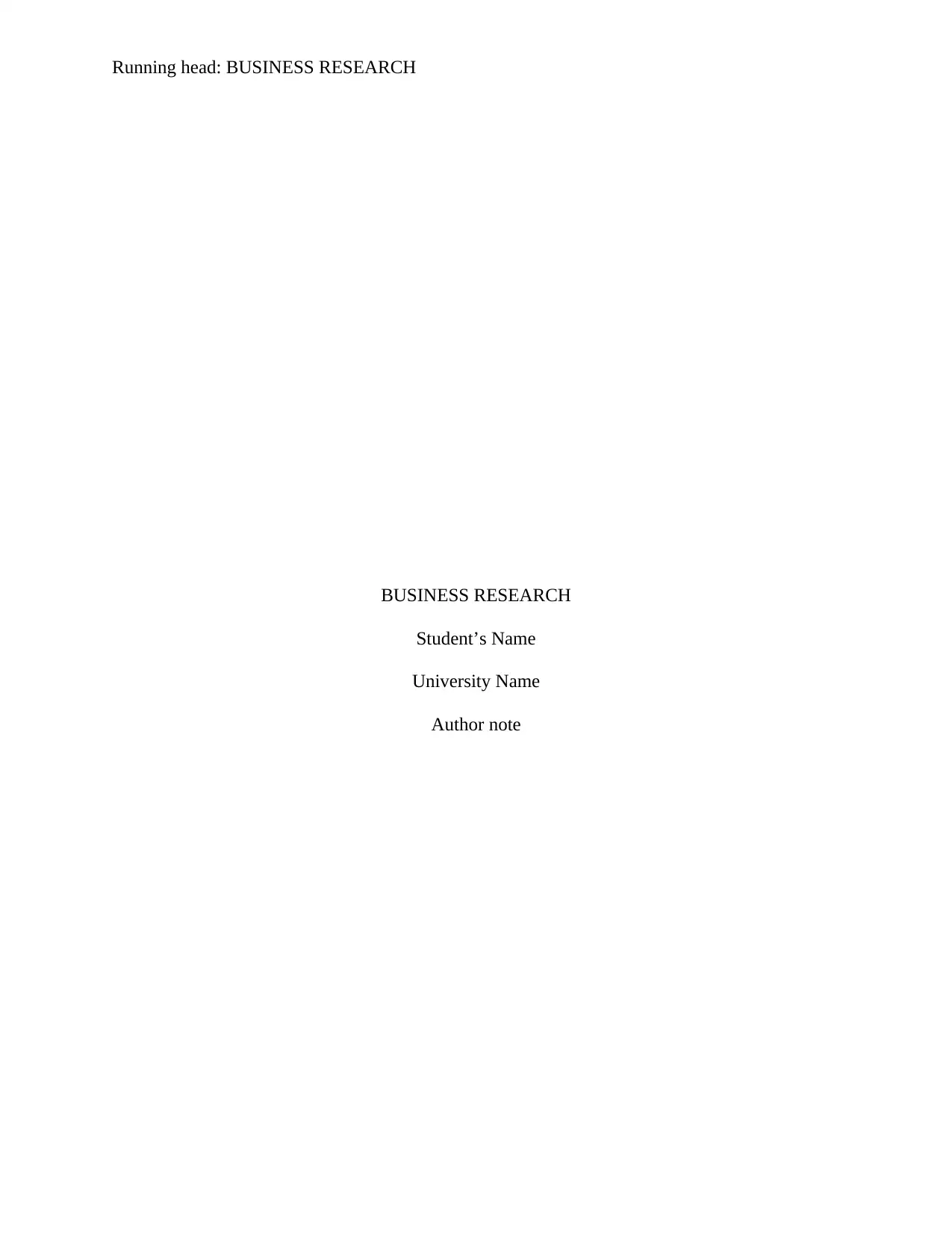
Running head: BUSINESS RESEARCH
BUSINESS RESEARCH
Student’s Name
University Name
Author note
BUSINESS RESEARCH
Student’s Name
University Name
Author note
Paraphrase This Document
Need a fresh take? Get an instant paraphrase of this document with our AI Paraphraser

1BUSINESS RESEARCH
Introduction
According to Bai & Guo, (2017), along with the advancement of technology and fast
technological improvements, the business organizations are provided with new ideas,
opportunities, and possibilities for developing and improving products and services as well as
their marketing activities. The information technology increases the efficiency of the companies
and enables them to provide innovative products and services to the customers. However, it has
been identified that fast growth and development of technology also negatively impacts the
organization as many of them are unable to cope up with the complexities of information
technology. The purpose of this report is to analyze various theories and models to determine the
complexity of information technology and the ways in which the organizations are impacted.
Research questions
The following research question will be addressed in the report:
How does complex information technology impacts business organizations?
Literature review
Findings
As per studies and research, it has been identified that information technology complexity
is growing exponentially. Adaption to latest and advanced technology has become a new trend
Introduction
According to Bai & Guo, (2017), along with the advancement of technology and fast
technological improvements, the business organizations are provided with new ideas,
opportunities, and possibilities for developing and improving products and services as well as
their marketing activities. The information technology increases the efficiency of the companies
and enables them to provide innovative products and services to the customers. However, it has
been identified that fast growth and development of technology also negatively impacts the
organization as many of them are unable to cope up with the complexities of information
technology. The purpose of this report is to analyze various theories and models to determine the
complexity of information technology and the ways in which the organizations are impacted.
Research questions
The following research question will be addressed in the report:
How does complex information technology impacts business organizations?
Literature review
Findings
As per studies and research, it has been identified that information technology complexity
is growing exponentially. Adaption to latest and advanced technology has become a new trend
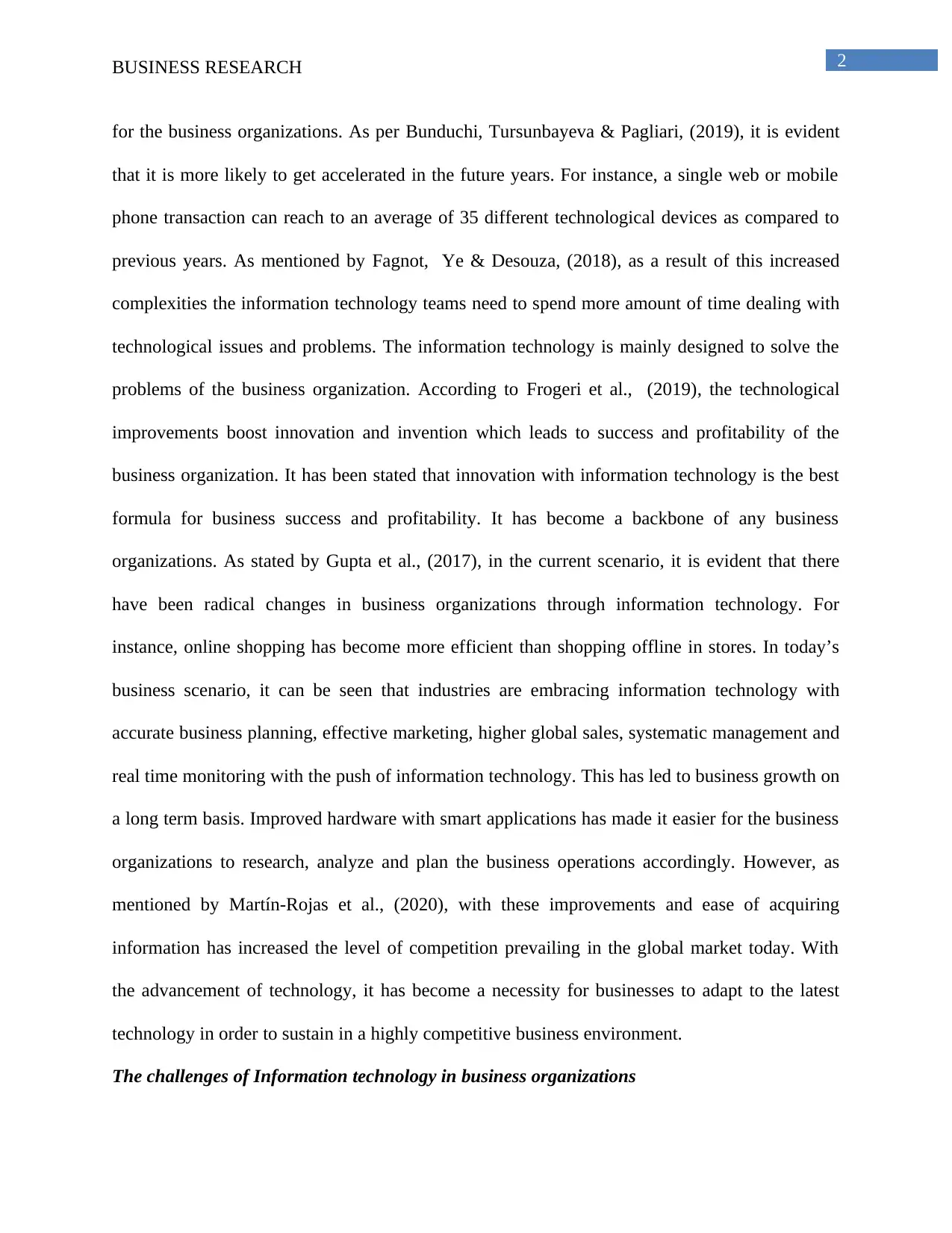
2BUSINESS RESEARCH
for the business organizations. As per Bunduchi, Tursunbayeva & Pagliari, (2019), it is evident
that it is more likely to get accelerated in the future years. For instance, a single web or mobile
phone transaction can reach to an average of 35 different technological devices as compared to
previous years. As mentioned by Fagnot, Ye & Desouza, (2018), as a result of this increased
complexities the information technology teams need to spend more amount of time dealing with
technological issues and problems. The information technology is mainly designed to solve the
problems of the business organization. According to Frogeri et al., (2019), the technological
improvements boost innovation and invention which leads to success and profitability of the
business organization. It has been stated that innovation with information technology is the best
formula for business success and profitability. It has become a backbone of any business
organizations. As stated by Gupta et al., (2017), in the current scenario, it is evident that there
have been radical changes in business organizations through information technology. For
instance, online shopping has become more efficient than shopping offline in stores. In today’s
business scenario, it can be seen that industries are embracing information technology with
accurate business planning, effective marketing, higher global sales, systematic management and
real time monitoring with the push of information technology. This has led to business growth on
a long term basis. Improved hardware with smart applications has made it easier for the business
organizations to research, analyze and plan the business operations accordingly. However, as
mentioned by Martín-Rojas et al., (2020), with these improvements and ease of acquiring
information has increased the level of competition prevailing in the global market today. With
the advancement of technology, it has become a necessity for businesses to adapt to the latest
technology in order to sustain in a highly competitive business environment.
The challenges of Information technology in business organizations
for the business organizations. As per Bunduchi, Tursunbayeva & Pagliari, (2019), it is evident
that it is more likely to get accelerated in the future years. For instance, a single web or mobile
phone transaction can reach to an average of 35 different technological devices as compared to
previous years. As mentioned by Fagnot, Ye & Desouza, (2018), as a result of this increased
complexities the information technology teams need to spend more amount of time dealing with
technological issues and problems. The information technology is mainly designed to solve the
problems of the business organization. According to Frogeri et al., (2019), the technological
improvements boost innovation and invention which leads to success and profitability of the
business organization. It has been stated that innovation with information technology is the best
formula for business success and profitability. It has become a backbone of any business
organizations. As stated by Gupta et al., (2017), in the current scenario, it is evident that there
have been radical changes in business organizations through information technology. For
instance, online shopping has become more efficient than shopping offline in stores. In today’s
business scenario, it can be seen that industries are embracing information technology with
accurate business planning, effective marketing, higher global sales, systematic management and
real time monitoring with the push of information technology. This has led to business growth on
a long term basis. Improved hardware with smart applications has made it easier for the business
organizations to research, analyze and plan the business operations accordingly. However, as
mentioned by Martín-Rojas et al., (2020), with these improvements and ease of acquiring
information has increased the level of competition prevailing in the global market today. With
the advancement of technology, it has become a necessity for businesses to adapt to the latest
technology in order to sustain in a highly competitive business environment.
The challenges of Information technology in business organizations
⊘ This is a preview!⊘
Do you want full access?
Subscribe today to unlock all pages.

Trusted by 1+ million students worldwide
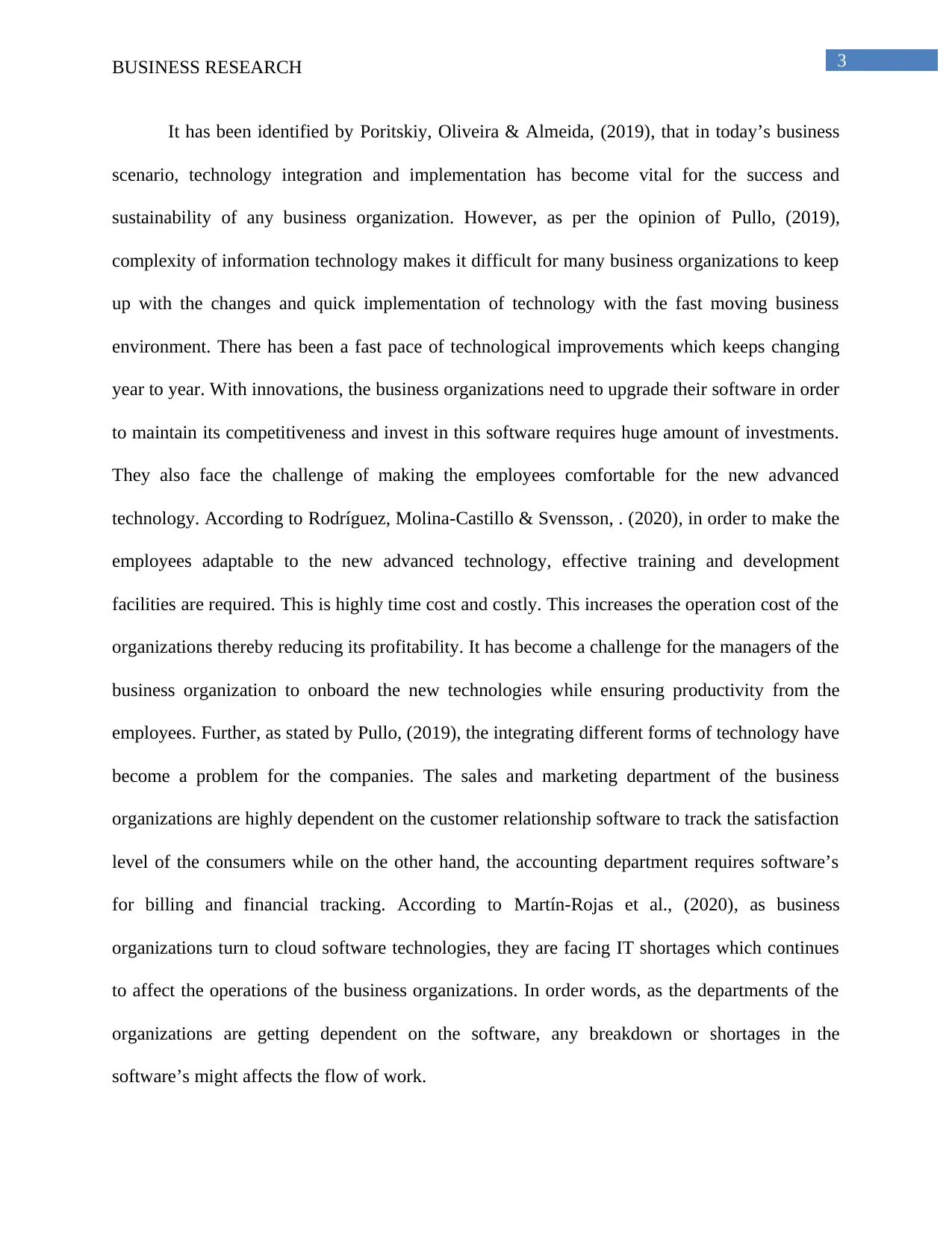
3BUSINESS RESEARCH
It has been identified by Poritskiy, Oliveira & Almeida, (2019), that in today’s business
scenario, technology integration and implementation has become vital for the success and
sustainability of any business organization. However, as per the opinion of Pullo, (2019),
complexity of information technology makes it difficult for many business organizations to keep
up with the changes and quick implementation of technology with the fast moving business
environment. There has been a fast pace of technological improvements which keeps changing
year to year. With innovations, the business organizations need to upgrade their software in order
to maintain its competitiveness and invest in this software requires huge amount of investments.
They also face the challenge of making the employees comfortable for the new advanced
technology. According to Rodríguez, Molina-Castillo & Svensson, . (2020), in order to make the
employees adaptable to the new advanced technology, effective training and development
facilities are required. This is highly time cost and costly. This increases the operation cost of the
organizations thereby reducing its profitability. It has become a challenge for the managers of the
business organization to onboard the new technologies while ensuring productivity from the
employees. Further, as stated by Pullo, (2019), the integrating different forms of technology have
become a problem for the companies. The sales and marketing department of the business
organizations are highly dependent on the customer relationship software to track the satisfaction
level of the consumers while on the other hand, the accounting department requires software’s
for billing and financial tracking. According to Martín-Rojas et al., (2020), as business
organizations turn to cloud software technologies, they are facing IT shortages which continues
to affect the operations of the business organizations. In order words, as the departments of the
organizations are getting dependent on the software, any breakdown or shortages in the
software’s might affects the flow of work.
It has been identified by Poritskiy, Oliveira & Almeida, (2019), that in today’s business
scenario, technology integration and implementation has become vital for the success and
sustainability of any business organization. However, as per the opinion of Pullo, (2019),
complexity of information technology makes it difficult for many business organizations to keep
up with the changes and quick implementation of technology with the fast moving business
environment. There has been a fast pace of technological improvements which keeps changing
year to year. With innovations, the business organizations need to upgrade their software in order
to maintain its competitiveness and invest in this software requires huge amount of investments.
They also face the challenge of making the employees comfortable for the new advanced
technology. According to Rodríguez, Molina-Castillo & Svensson, . (2020), in order to make the
employees adaptable to the new advanced technology, effective training and development
facilities are required. This is highly time cost and costly. This increases the operation cost of the
organizations thereby reducing its profitability. It has become a challenge for the managers of the
business organization to onboard the new technologies while ensuring productivity from the
employees. Further, as stated by Pullo, (2019), the integrating different forms of technology have
become a problem for the companies. The sales and marketing department of the business
organizations are highly dependent on the customer relationship software to track the satisfaction
level of the consumers while on the other hand, the accounting department requires software’s
for billing and financial tracking. According to Martín-Rojas et al., (2020), as business
organizations turn to cloud software technologies, they are facing IT shortages which continues
to affect the operations of the business organizations. In order words, as the departments of the
organizations are getting dependent on the software, any breakdown or shortages in the
software’s might affects the flow of work.
Paraphrase This Document
Need a fresh take? Get an instant paraphrase of this document with our AI Paraphraser
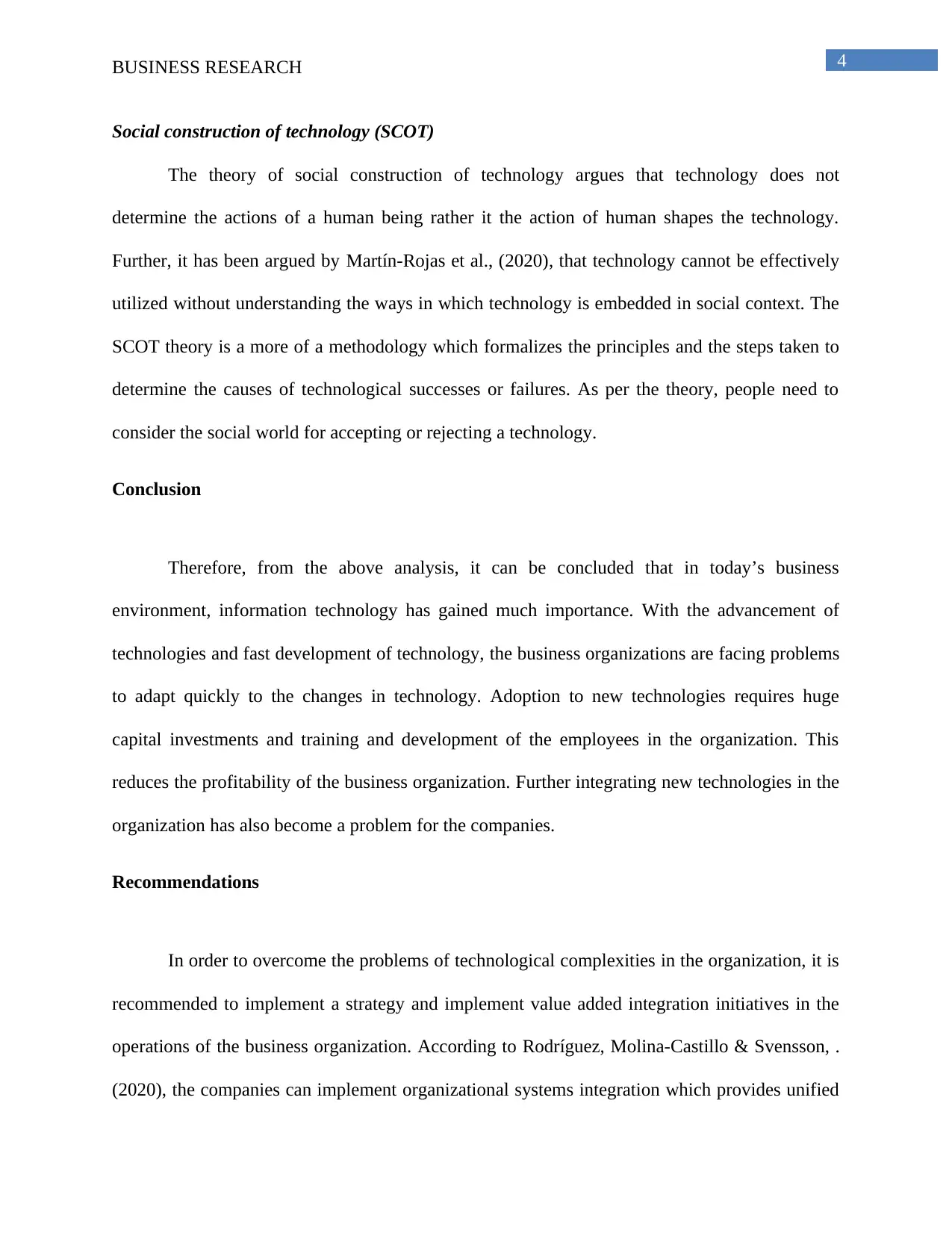
4BUSINESS RESEARCH
Social construction of technology (SCOT)
The theory of social construction of technology argues that technology does not
determine the actions of a human being rather it the action of human shapes the technology.
Further, it has been argued by Martín-Rojas et al., (2020), that technology cannot be effectively
utilized without understanding the ways in which technology is embedded in social context. The
SCOT theory is a more of a methodology which formalizes the principles and the steps taken to
determine the causes of technological successes or failures. As per the theory, people need to
consider the social world for accepting or rejecting a technology.
Conclusion
Therefore, from the above analysis, it can be concluded that in today’s business
environment, information technology has gained much importance. With the advancement of
technologies and fast development of technology, the business organizations are facing problems
to adapt quickly to the changes in technology. Adoption to new technologies requires huge
capital investments and training and development of the employees in the organization. This
reduces the profitability of the business organization. Further integrating new technologies in the
organization has also become a problem for the companies.
Recommendations
In order to overcome the problems of technological complexities in the organization, it is
recommended to implement a strategy and implement value added integration initiatives in the
operations of the business organization. According to Rodríguez, Molina-Castillo & Svensson, .
(2020), the companies can implement organizational systems integration which provides unified
Social construction of technology (SCOT)
The theory of social construction of technology argues that technology does not
determine the actions of a human being rather it the action of human shapes the technology.
Further, it has been argued by Martín-Rojas et al., (2020), that technology cannot be effectively
utilized without understanding the ways in which technology is embedded in social context. The
SCOT theory is a more of a methodology which formalizes the principles and the steps taken to
determine the causes of technological successes or failures. As per the theory, people need to
consider the social world for accepting or rejecting a technology.
Conclusion
Therefore, from the above analysis, it can be concluded that in today’s business
environment, information technology has gained much importance. With the advancement of
technologies and fast development of technology, the business organizations are facing problems
to adapt quickly to the changes in technology. Adoption to new technologies requires huge
capital investments and training and development of the employees in the organization. This
reduces the profitability of the business organization. Further integrating new technologies in the
organization has also become a problem for the companies.
Recommendations
In order to overcome the problems of technological complexities in the organization, it is
recommended to implement a strategy and implement value added integration initiatives in the
operations of the business organization. According to Rodríguez, Molina-Castillo & Svensson, .
(2020), the companies can implement organizational systems integration which provides unified
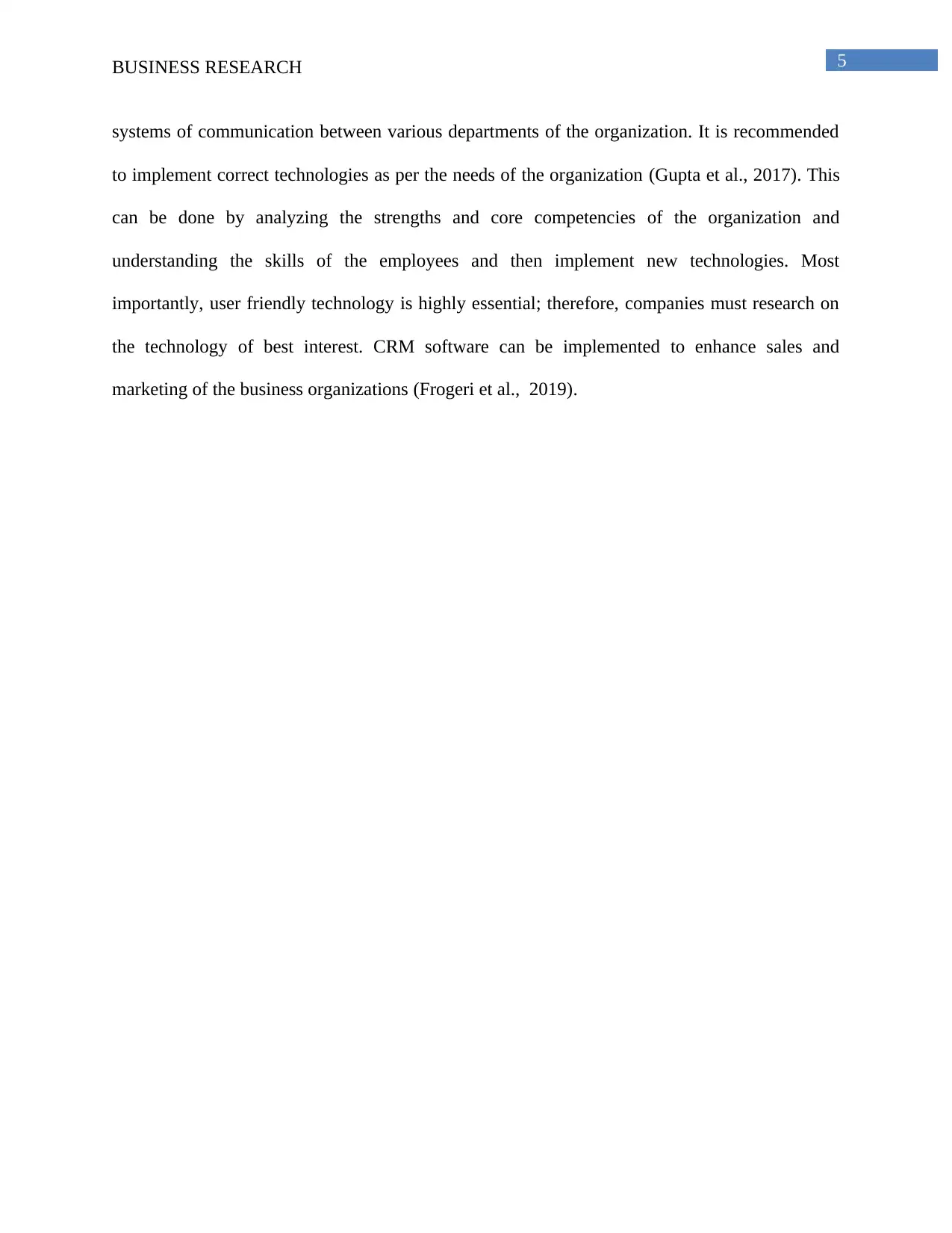
5BUSINESS RESEARCH
systems of communication between various departments of the organization. It is recommended
to implement correct technologies as per the needs of the organization (Gupta et al., 2017). This
can be done by analyzing the strengths and core competencies of the organization and
understanding the skills of the employees and then implement new technologies. Most
importantly, user friendly technology is highly essential; therefore, companies must research on
the technology of best interest. CRM software can be implemented to enhance sales and
marketing of the business organizations (Frogeri et al., 2019).
systems of communication between various departments of the organization. It is recommended
to implement correct technologies as per the needs of the organization (Gupta et al., 2017). This
can be done by analyzing the strengths and core competencies of the organization and
understanding the skills of the employees and then implement new technologies. Most
importantly, user friendly technology is highly essential; therefore, companies must research on
the technology of best interest. CRM software can be implemented to enhance sales and
marketing of the business organizations (Frogeri et al., 2019).
⊘ This is a preview!⊘
Do you want full access?
Subscribe today to unlock all pages.

Trusted by 1+ million students worldwide
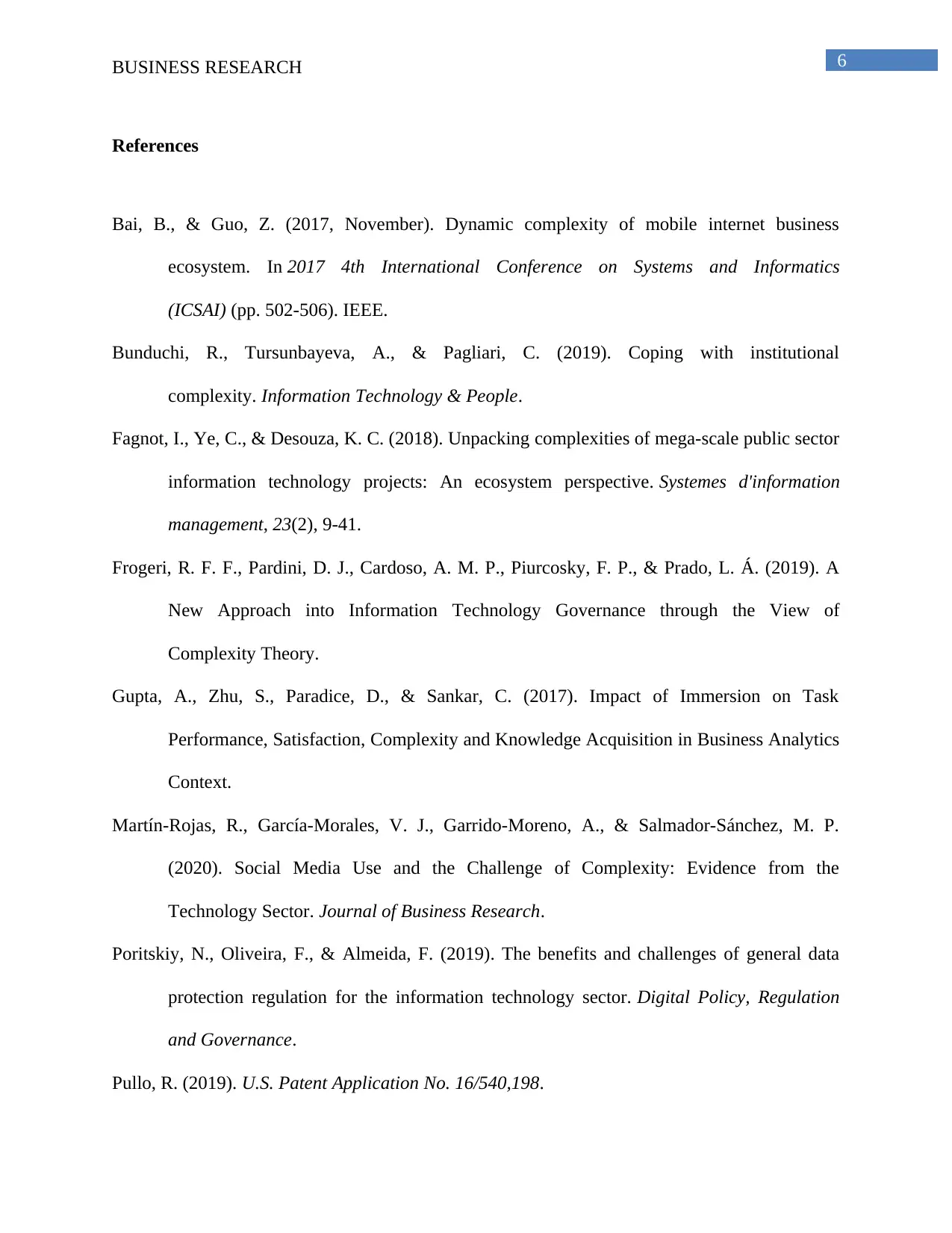
6BUSINESS RESEARCH
References
Bai, B., & Guo, Z. (2017, November). Dynamic complexity of mobile internet business
ecosystem. In 2017 4th International Conference on Systems and Informatics
(ICSAI) (pp. 502-506). IEEE.
Bunduchi, R., Tursunbayeva, A., & Pagliari, C. (2019). Coping with institutional
complexity. Information Technology & People.
Fagnot, I., Ye, C., & Desouza, K. C. (2018). Unpacking complexities of mega-scale public sector
information technology projects: An ecosystem perspective. Systemes d'information
management, 23(2), 9-41.
Frogeri, R. F. F., Pardini, D. J., Cardoso, A. M. P., Piurcosky, F. P., & Prado, L. Á. (2019). A
New Approach into Information Technology Governance through the View of
Complexity Theory.
Gupta, A., Zhu, S., Paradice, D., & Sankar, C. (2017). Impact of Immersion on Task
Performance, Satisfaction, Complexity and Knowledge Acquisition in Business Analytics
Context.
Martín-Rojas, R., García-Morales, V. J., Garrido-Moreno, A., & Salmador-Sánchez, M. P.
(2020). Social Media Use and the Challenge of Complexity: Evidence from the
Technology Sector. Journal of Business Research.
Poritskiy, N., Oliveira, F., & Almeida, F. (2019). The benefits and challenges of general data
protection regulation for the information technology sector. Digital Policy, Regulation
and Governance.
Pullo, R. (2019). U.S. Patent Application No. 16/540,198.
References
Bai, B., & Guo, Z. (2017, November). Dynamic complexity of mobile internet business
ecosystem. In 2017 4th International Conference on Systems and Informatics
(ICSAI) (pp. 502-506). IEEE.
Bunduchi, R., Tursunbayeva, A., & Pagliari, C. (2019). Coping with institutional
complexity. Information Technology & People.
Fagnot, I., Ye, C., & Desouza, K. C. (2018). Unpacking complexities of mega-scale public sector
information technology projects: An ecosystem perspective. Systemes d'information
management, 23(2), 9-41.
Frogeri, R. F. F., Pardini, D. J., Cardoso, A. M. P., Piurcosky, F. P., & Prado, L. Á. (2019). A
New Approach into Information Technology Governance through the View of
Complexity Theory.
Gupta, A., Zhu, S., Paradice, D., & Sankar, C. (2017). Impact of Immersion on Task
Performance, Satisfaction, Complexity and Knowledge Acquisition in Business Analytics
Context.
Martín-Rojas, R., García-Morales, V. J., Garrido-Moreno, A., & Salmador-Sánchez, M. P.
(2020). Social Media Use and the Challenge of Complexity: Evidence from the
Technology Sector. Journal of Business Research.
Poritskiy, N., Oliveira, F., & Almeida, F. (2019). The benefits and challenges of general data
protection regulation for the information technology sector. Digital Policy, Regulation
and Governance.
Pullo, R. (2019). U.S. Patent Application No. 16/540,198.
Paraphrase This Document
Need a fresh take? Get an instant paraphrase of this document with our AI Paraphraser
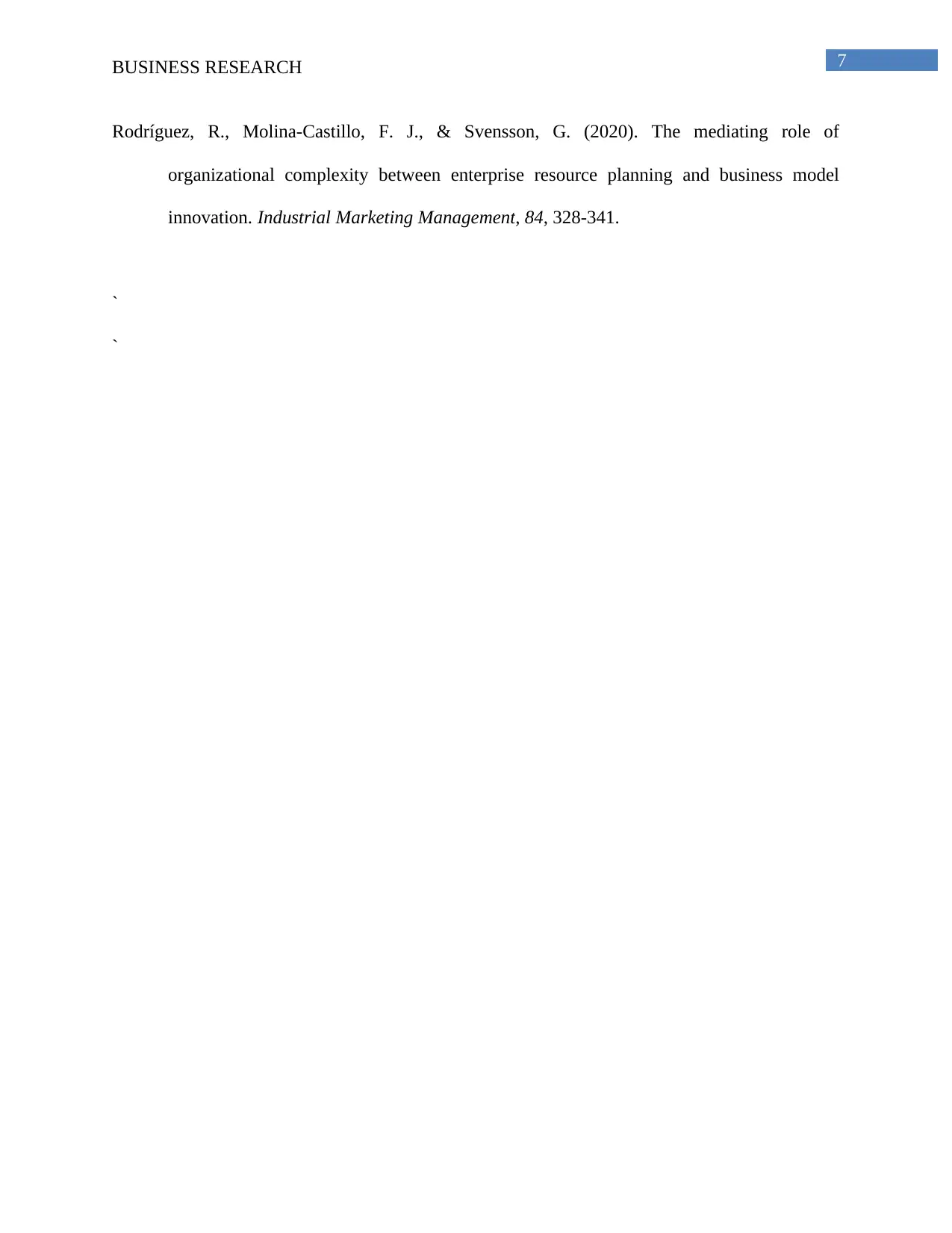
7BUSINESS RESEARCH
Rodríguez, R., Molina-Castillo, F. J., & Svensson, G. (2020). The mediating role of
organizational complexity between enterprise resource planning and business model
innovation. Industrial Marketing Management, 84, 328-341.
`
`
Rodríguez, R., Molina-Castillo, F. J., & Svensson, G. (2020). The mediating role of
organizational complexity between enterprise resource planning and business model
innovation. Industrial Marketing Management, 84, 328-341.
`
`
1 out of 8
Related Documents
Your All-in-One AI-Powered Toolkit for Academic Success.
+13062052269
info@desklib.com
Available 24*7 on WhatsApp / Email
![[object Object]](/_next/static/media/star-bottom.7253800d.svg)
Unlock your academic potential
Copyright © 2020–2025 A2Z Services. All Rights Reserved. Developed and managed by ZUCOL.





